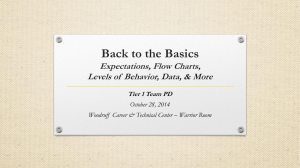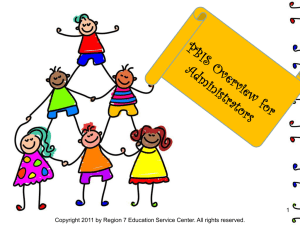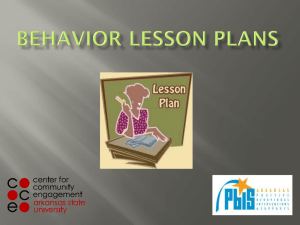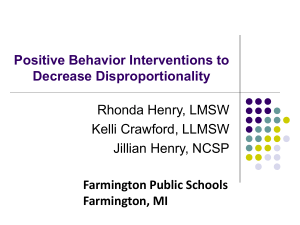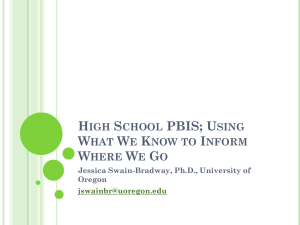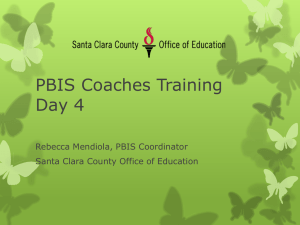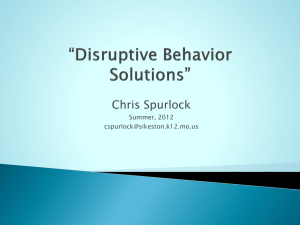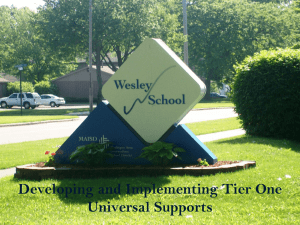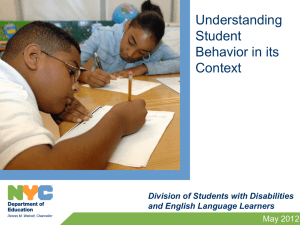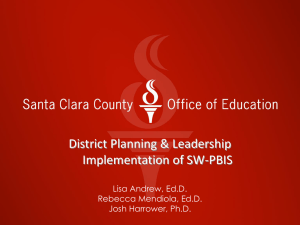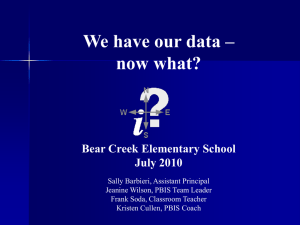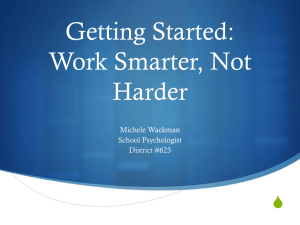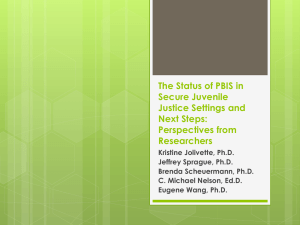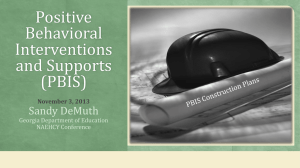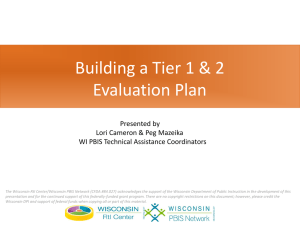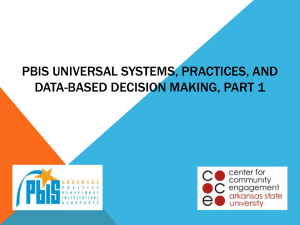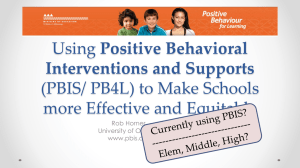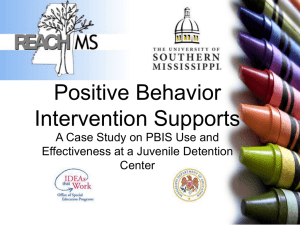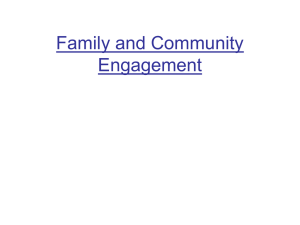New Team Training Overview
advertisement
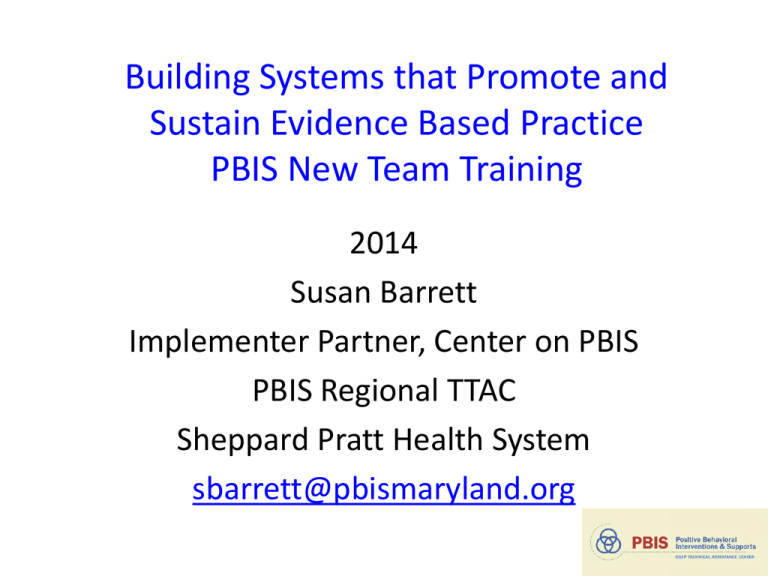
Building Systems that Promote and Sustain Evidence Based Practice PBIS New Team Training 2014 Susan Barrett Implementer Partner, Center on PBIS PBIS Regional TTAC Sheppard Pratt Health System sbarrett@pbismaryland.org PowerPoint and training content available www.pbismaryland.org Other websites www.pbis.org www.pbisilliniois.org 2 Goals for Today Introduction to the PBIS Framework Big Ideas to promote change Using the BOQ to launch PBIS effort 3 Team Training Expectations EXPECTATION BEHAVIOR BE RESPONSIBLE Make yourself comfortable Take care of your needs Return quickly and quietly Tell us your questions BE RESPECTFUL Turn cell phones off or to “vibrate” Listen to others attentively Contribute to the team Follow up on assigned tasks BE ENGAGED Share your passion Take notes Plan with your team Have FUN!!!! 4 PBIS Framework • Defined • Outcomes • 3 Big Ideas: What makes this acronym different? – Implementation Science: Fits the context and culture – Workforce Development: “Press and Support” – Equal Priority: Emotional Health and Wellbeing, Executive Functioning Skills 5 Equal Priority Academic Rigor Social Emotional Health/ Mental Wellness/Physical Health Close the Global Gap and Healthy Country Healthcare/economy Adapted from © Fixsen and Blase 2013, Barrett 2013 Organizational Health: Workforce What is School-wide Positive Behavior Support? • School-wide PBIS is: – IS a decision making framework that guides selection, integration, and implementation of the best evidence-based academic and behavioral practices for improving important academic and behavior outcomes for all students. • Evidence-based features of SW-PBIS – Prevention – Define and teach positive social expectations – Acknowledge positive behavior – Arrange consistent consequences for problem behavior – On-going collection and use of data for decision-making – Continuum of intensive, individual interventions. – Administrative leadership – Team-based implementation (Systems that support effective practices) PBIS Implementation Framework Social Emotional and Behavioral Health • We organize our resources – Multi-Tier Mapping, Gap Analysis • So kids get help early – Actions based on outcomes (data!), not procedures • We do stuff that’s likely to work – Evidence-Based interventions • We provide supports to staff to do it right – Fidelity: Benchmarks of Quality • And make sure they’re successful – – – – Coaching and Support Progress monitoring and performance feedback Problem-Solving process Increasing levels of intensity Establishing the Conditions for Learning School Climate Engagement Safety Environment Relationships Emotional Safety Physical Environment Respect for Diversity Physical Safety Academic Environment School Participation Substance Use Wellness Disciplinary Environment 3/11/2012 Kristen Harper, Office of Safe and Healthy Students, United States Department of Education Three Tiered Model of Student Supports get these tiers of support These students + The goal of the tiers is student success, not labeling. in order to meet benchmarks. = TIER I: Core, Universal GOAL: 100% of students achieve at high levels Tier I: Implementing well researched programs and practices demonstrated to produce good outcomes for the majority of students. Tier I: Effective if at least 80% are meeting benchmarks with access to Core/Universal Instruction. Tier I: Begins with clear goals: 1.What exactly do we expect all students to learn ? 2.How will we know if and when they’ve learned it? 3.How you we respond when some students don’t learn? 4.How will we respond when some students have already learned? Questions 1 and 2 help us ensure a guaranteed and viable core curriculum 11 11 Impacts of SW-PBIS on Student Outcomes • Significant reduction in school-level suspensions • Students in PBIS schools were 32% less likely to receive an office discipline referral • A positive effect for school-level academic performance (Bradshaw et al., JPBI, 2010) • Significant reductions in teacher-rated behavior problems • Rejection & bullying (Waasdorp, Bradshaw, & Leaf, 2012) • Service use (e.g., counseling, special education referral, office referrals) • Reductions in concentration problems and aggressive/disruptive behavior, and improvements in prosocial behavior and emotion regulation (Bradshaw et al., submitted) • Some indication that the intervention effects are strongest the earlier students are exposed to SW-PBIS (Bradshaw et al., submitted) Big Idea #1 Implementation Science • Implementation is not a single event • A mission-oriented process involving multiple decisions, actions, and correctionsContinuous Improvement/Regeneration • Uses stages to make the process of change doable • Anchored to tiered framework • Always connected to strategic plan Stages of Implementation Focus Should we do it Stage Exploration/ Adoption Decision regarding commitment to adopting the program/practices and supporting successful implementation. Installation Set up infrastructure so that successful implementation can take place and be supported. Establish team and data systems, conduct audit, develop plan. Initial Implementation Try out the practices, work out details, learn and improve before expanding to other contexts. Elaboration Expand the program/practices to other locations, individuals, times- adjust from learning in initial implementation. Continuous Improvement/Re generation Make it easier, more efficient. Embed within current practices. Getting it right Making it better Description The “What” and The “How” Big Idea #2 Workforce Development Snider 2006 “ I learned very little in my undergraduate teacher education program about how to teach; and for those 8 years I relied on luck, trial and error and the competence of colleagues for my professional development. I regret that I didn’t know more from the beginning because despite my earnest efforts, my students didn’t achieve as much as they could have. I knew very little about curriculum, effective teaching, or principles of classroom management beyond what I learned on the job.” (p. 2) System Change “For every increment of performance I demand from you, I have an equal responsibility to provide you with the capacity to meet that expectation” (R. Elmore, 2002) Training Outcomes Related to Training Components Press and Support Training Outcomes Training Components Presentation/ Lecture Plus Demonstration Plus Practice Plus Coaching/ Admin Support Data Feedback Knowledge of Content Skill Implementation Classroom Application 10% 5% 0% 30% 20% 0% 60% 60% 5% 95% 95% Joyce & Showers, 2002 95% Leaders…“Call to Action” How do we ensure that all students have access to effective practices that are implemented with fidelity and sustained over time? **2 key components for School Improvement: 1. Professional Development – Nurture the growth and development of our staff!!! Focus on skill development and support of individual educators 2. Organization Capacity-Learn and be adaptive Focus on strong collaborative work cultures Big Idea #3 We are Social Beings first and foremost!!! • Neurobiology and Social Connectedness • Kernels of EBP within an implementation framework…. – Imitation to empathy – modeling behavior we want to see around us – Fostering mutual care Relationships and Youth Connectedness ESSENTIAL to children’s well being. • A sample of 2,022 students (999 boys and 1,023 girls) ages 12-14 years was measured at two time points twelve months apart on school connectedness and mental health symptoms (general functioning, depression, and anxiety symptoms). After adjusting for any prior conditions that could have led to mental health problems, the authors of the study reported stronger than previous evidence of the association with school connectedness and adolescent depressive symptoms and a predictive link between school connectedness to future mental health problems. • 22 Early studies suggest that there are substantial percentages of violent youth who do not perceive themselves to be liked by classmates and who report loneliness. (Clin, 2006 Adol Psychology) Worry • Do we live in a punishing work environment ? • How do we create systems that support staff? 22 Get honest about issues or concerns in your building – Administrator is key!! Establish a kind of “haven”- place that individuals can get feel safe about reporting concerns, supported by school community and empowered to be a part of the decision making process“Community of Practice” – – Tools: Self Assessment, Fidelity Checks, ODRs, climate surveys, satisfaction surveys Provide data summaries within a week of return – decide best approach to deliver feedback 23 Impacts of SW-PBIS on Student Outcomes • Significant reduction in school-level suspensions • Students in PBIS schools were 32% less likely to receive an office discipline referral • A positive effect for school-level academic performance (Bradshaw et al., JPBI, 2010) • Significant reductions in teacher-rated behavior problems • Rejection & bullying (Waasdorp, Bradshaw, & Leaf, 2012) • Service use (e.g., counseling, special education referral, office referrals) • Reductions in concentration problems and aggressive/disruptive behavior, and improvements in prosocial behavior and emotion regulation (Bradshaw et al., submitted) • Some indication that the intervention effects are strongest the earlier students are exposed to SW-PBIS (Bradshaw et al., submitted) SW PBIS Critical Elements 1. PBIS Team 2. Faculty/Staff Commitment 3. Effective Procedures for Dealing with Problem Behaviors 4. Data Entry and Analysis Plan Established 5. Expectations and Rules Developed 6. Acknowledgement System Established 7. Develop Plans for Teaching Expectations/Rules 8. Implementation Plan 9. Classroom Systems 10.Evaluation Our Day • Outcome: Personalized School Action Plan – – – – – Anchored on Benchmarks of Quality Activity Based: “Conversation Starters” Resources: Electronic Coach for guiding and facilitating 3-5 Years • Action Planning Form • Computer: Access to pbismaryland -USED ALL YEAR • Role Assignments (note taker, facilitator, time keeper) 26 Group Roles Facilitator- The facilitator ensures that the group moves smoothly through the task at hand. This person seeks information and opinions, asks for facts and feelings from each team member, and summarizes main points of discussion. This role is very important because the facilitator leads the group through the task. Recorder/Minute Taker- The recorder writes down the work of the group. This can involve writing words or sentences, drawing pictures, or simply taking notes of an activity. This role is very important because it is necessary to keep a record of the work done. Time Keeper - This person takes on two roles. First of all, they are responsible for keeping up with the time. It is very important that the group is aware of how much time they have to complete the task as well as reminders on when the time is growing short. Reporter/Communicator- This person is responsible for reporting back the work of their small group to the presenter or to the larger group. This role is very important because this communication to the large group will be crucial in the learning process. Encourager- This person is responsible for keeping the group motivated and on task. The encourager acts as the cheerleader as the group moves though their various tasks providing behavior specific praise. This role is very important because it is crucial that the group stays on task as time is limited. PBIS • Examine Current Condition – Terms of Reference – Resource Mapping – Working Smarter to support staff What kind of school to you want your school to be? What are the outcomes you seek? 28 Activity Terms of Reference • Words have meaning • What do they mean to you? • • • • • • • Discipline Suspension Office Referral Bullying At Risk Graduation Requirements State Accountability Tests 29 Activity Resource Mapping 30 Before you add one more thing…. www.safetycenter.navy.mil Triangle Activity: Applying the Three-Tiered Logic to Your School Tier 3 Practices, Initiatives, Programs for a FEW Tier 2 Practices, Initiatives, Programs for SOME Tier 1 Practices, Initiatives, Programs for ALL Resource Mapping • What are the practices in place at each tier of the triangle? • Are they evidence-based practices? • How are you measuring effectiveness of practices (data)? • Who are the service delivery teams/personnel? 33

